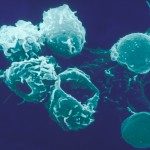Link to Pubmed [PMID] – 11027341
Proc. Natl. Acad. Sci. U.S.A. 2000 Oct;97(21):11415-20
The Ig and T cell receptor (TCR) loci have an exceptionally dynamic evolutionary history, but the mechanisms responsible remain a subject of speculation. Ig and TCR genes are unique in vertebrates in that they are assembled from V, D, and J segments by site-specific recombination in developing lymphocytes. Here we examine the extent to which the V(D)J recombination in germline cells may have been responsible for remodeling Ig and TCR loci in mammals by asking whether gene segments have evolved as a unit, or whether, instead, recombination signal sequences (RSSs) and coding sequences have different phylogenies. Four distinct types of RSS have been defined in the human Ig heavy-chain variable region (Vh) locus, namely H1, H2, H3, and H5, and no other RSS type has been detected in other mammalian species. There is a well-supported discrepancy between the evolutionary history of the RSSs as compared with the Vh coding sequences: the RSS type H2 of one Vh gene segment has clearly become replaced by a RSS type H3 during mammalian evolution, between 115 and 65 million years ago. Two general models might explain the RSS swap: the first involves an unequal crossing over, and the second implicates germline activation of V(D)J recombination. The Vh-H2/RSS-H3 recombination product has likely been selected during the evolution of mammals because it provides better V(D)J recombination efficiency.

